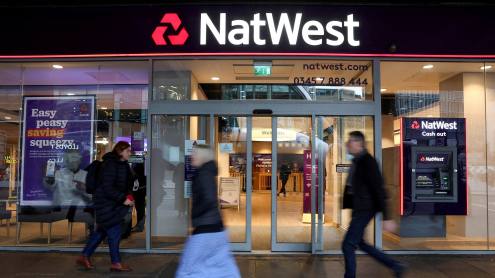The much-anticipated plan envisages 1.58 billion new shares being offered to Temasek Holdings of Singapore, the Qatar Investment Authority, China Development Bank, Sumitomo Mitsui Financial Group and Challenger, a company representing Qatar’s royal family.
To stave off complaints from institutional investors in the UK, the bank announced the shares can be “clawed back” by investors who already hold bank stock. They will be able to but three new shares for every 14 shares they already own.
In a mark of confidence, chief executive John Varley said that only half the funds will be used to bolster its balance sheet, while the rest will be used for new business opportunities.
James Hutson, and analyst at KBW, sees the move as positive, since core capital will be above 6%, there were no further write-downs announced and the dividend will be paid in cash with an 11% yield.
Temasek Holdings and the Qatar Investment Authority are among the sovereign wealth funds investing in the bank. Temasek acquired a 2% stake in Barclays last year. A UK investment by the QIA, which has a 15.2% holding in the London Stock Exchange, has been expected since Sheik Hamad bin Jassem Al-Thani, the Qatar prime minister, told the World Economic Forum earlier this year that the US and European banks were potential investment targets. Sheikh Abdul Aziz bin Khalifa Al-Thani, a member of the Qatari royal family, which controls the QIA, has however publicly criticised Barclays over an alleged €50m ($78m) fraud in Spain.
The QIA has invested about $500m in Credit Suisse’s shares in February. The Swiss bank is one of Barclays’s investment banking advisers.
China Development Bank has previously invested in the London-based bank and together with Temasek, the two institutions invested more than £2.4bn last summer, as part of Barclays’s efforts to support its failed bid for ABN AMRO.
In the past 18 months, Barclays had suffered a total $5.2bn in write-downs and credit losses and had raised capital for $9.7bn. This year, the bank has written off £1.7bn on complex debt securities but some analysts say that the bank has been less conservative than some of its rivals in marking down assets related to the US subprime crisis.
The equity placement with specific investors assists Barclays in rebuilding its capital reserves without resorting to a rights issue for which a suitable strike price might be difficult to determine. The capital injection would lift the bank’s Tier 1 capital to 6.1%, which, however, would still leave Barclays as one of the worst capitalised banks in Europe.
The bank has recently made about 100 people redundant in its investment banking and IT support divisions, causing its leveraged finance team to shrink. Barclays Capital, the bank’s investment arm, has also hired a team of healthcare bankers from Bear Stearns, which has been recently bought by JPMorgan. The move highlights Barclays’s intentions to grow its US business.
Exchanges seek new roles The New York Stock Exchange and Nasdaq have struck deals to allow their clients greater access to dark liquidity pools, in a move aimed at gaining revenue from the growing volume of trades directed through these anonymous electronic trading networks. The exchanges are seeking a new role as aggregators and plan to offer clients maximum access to dark pools at any one time.
Goldman Sachs, Morgan Stanley and UBS have decided to link their private stock trading operations to improve liquidity and compete better with the increasing number of alternative exchanges. The move would give clients of each bank access to the others’ so-called dark liquidity pools – the private interbank or intra-bank platforms widely used to trade stocks away from exchanges. The arrangement will firstly apply to the US.
Goldman Sachs has announced that it will restructure the first of a string of collapsed investment vehicles. The receivers of the $7bn structured investment vehicle formerly run by London-based hedge fund Cheyne Capital have confirmed the agreement to restructure and sell the portfolio to the US bank. Meanwhile, unsecured creditors of Bayou Group have received court permission to file a $20.6bn lawsuit against the bank’s execution and clearing division, which was the hedge fund’s trading broker.
Switzerland’s central bank has demanded that UBS and Credit Suisse build a bigger financial cushion to avoid another financial disaster after the dire consequences of the subprime crisis.
Credit Suisse has secured regulatory approval to set up a Chinese securities joint venture to provide investment banking services to mainland clients. China Securities Regulatory Commission’s decision is expected to attract a wave of foreign direct investment in the sector following a two-year ban.
BNP buys brokerage arm
BNP Paribas has bought Bank of America’s prime brokerage arm for up to $300m, taking advantage of its more stressed rival. Bank of America decided earlier this year to scale back its investment banking operations after suffering credit product-related losses.
The European Commission has announced that it is planning to regulate bond-rating companies, mirroring similar efforts by US officials to address the causes of the credit crunch. The legislation will tackle conflict of interest at rating agencies and enforce fire walls between their operations.
S&P reports US glitch
Credit agency Standard & Poor’s has told US regulators that it found an error in the computer models underpinning the credit ratings of complex debt products, but that the fault did not affect the ratings of the debt. This follows an inquiry from the US Securities and Exchange Commission.
Kuwait’s investment bank Global Investment House has announced plans to raise $500m for a new private equity fund that will invest in financial services companies across the Middle East and north Africa.






